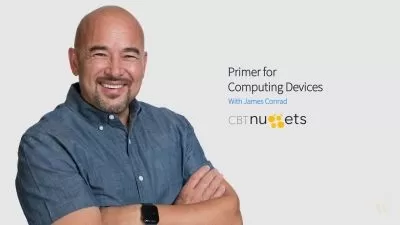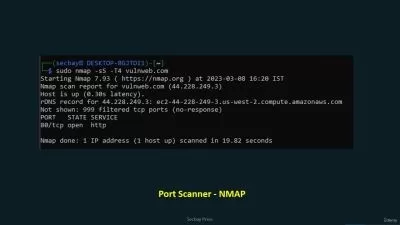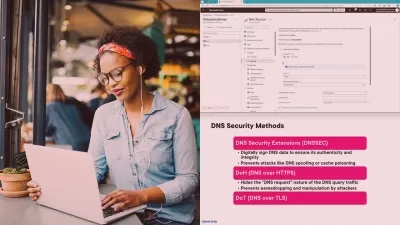01.01-promotional_video.mp4
00:23
01.02-introduction.mp4
02:38
01.03-whats_on_the_networkand_exam.mp4
02:23
01.04-what_can_you_do_with_a_networkand_certification.mp4
03:13
01.05-what_is_a_model.mp4
01:37
01.06-the_osi_model.mp4
12:30
01.07-meet_the_frame.mp4
05:44
01.08-the_mac_address.mp4
07:12
01.09-broadcast_versus_unicast.mp4
04:10
01.10-introduction_to_ip_addressing.mp4
07:32
01.11-packets_and_ports.mp4
04:49
02.01-network_topologies.mp4
04:43
02.02-coaxial_cabling.mp4
04:42
02.03-twisted_pair_cabling.mp4
05:26
02.04-fiber_optic_cabling.mp4
08:33
02.05-fire_ratings.mp4
05:13
03.01-what_is_ethernet.mp4
06:22
03.02-ethernet_frames.mp4
06:35
03.03-terminating_twisted_pair.mp4
08:12
03.04-hubs_versus_switches.mp4
12:29
03.05-connecting_switches.mp4
05:22
04.01-100baset.mp4
05:15
04.02-gigabit_ethernet_and_10-gigabit_ethernet.mp4
04:45
04.03-transceivers.mp4
07:01
04.04-connecting_ethernet_scenarios.mp4
13:51
05.01-introduction_to_structured_cabling.mp4
04:08
05.02-terminating_structured_cabling.mp4
07:45
05.03-equipment_room.mp4
07:10
05.04-alternative_distribution_panels.mp4
03:41
05.05-testing_cable.mp4
08:43
05.06-troubleshooting_structured_cabling_part_1.mp4
04:09
05.07-troubleshooting_structured_cabling_part_2.mp4
03:39
05.08-using_a_toner_and_probe.mp4
02:36
05.09-wired_connection_scenarios.mp4
10:21
06.01-introduction_to_ip_addressing_and_binary.mp4
12:33
06.02-introduction_to_arp.mp4
03:37
06.03-subnet_masks.mp4
12:00
06.04-classful_addressing.mp4
10:10
06.05-subnetting_with_cidr.mp4
09:36
06.06-more_cidr_subnetting_practice.mp4
09:48
06.07-dynamic_and_static_ip_addressing.mp4
13:38
06.08-special_ip_addresses.mp4
06:52
06.09-ip_addressing_scenarios.mp4
14:38
07.01-introducing_routers.mp4
15:09
07.02-understanding_ports.mp4
05:17
07.03-network_address_translation.mp4
06:15
07.04-implementing_nat.mp4
02:28
07.05-forwarding_ports.mp4
17:31
07.06-tour_of_a_soho_router.mp4
11:53
07.07-soho_versus_enterprise.mp4
08:32
07.08-static_routes.mp4
12:31
07.09-dynamic_routing.mp4
10:27
07.10-rip.mp4
04:18
07.11-ospf.mp4
03:25
07.12-bgp.mp4
05:30
08.01-tcp_and_udp.mp4
07:13
08.02-icmp_and_igmp.mp4
05:59
08.03-handy_tools.mp4
06:35
08.04-introduction_to_wireshark.mp4
10:29
08.05-introduction_to_netstat.mp4
08:42
08.06-web_servers.mp4
11:43
08.07-ftp.mp4
11:37
08.08-email_servers_and_clients.mp4
09:09
08.09-securing_email.mp4
05:39
08.10-telnet_and_ssh.mp4
09:08
08.11-network_time_protocol.mp4
02:47
08.12-network_service_scenarios.mp4
09:25
09.01-understanding_dns.mp4
06:47
09.02-applying_dns.mp4
18:47
09.03-net_command.mp4
08:03
09.04-windows_name_resolution.mp4
11:14
09.05-dynamic_dns.mp4
05:13
09.06-dns_troubleshooting.mp4
13:04
10.01-making_tcpip_secure.mp4
04:17
10.02-symmetric_encryption.mp4
05:24
10.03-asymmetric_encryption.mp4
03:12
10.04-cryptographic_hashes.mp4
04:48
10.05-identification.mp4
08:00
10.06-access_control.mp4
04:12
10.07-aaa.mp4
04:51
10.08-kerberoseap.mp4
07:24
10.09-single_sign-on.mp4
10:01
10.10-certificates_and_trust.mp4
13:53
10.11-certificate_error_scenarios.mp4
07:58
11.01-switch_management.mp4
08:54
11.02-introduction_to_vlans.mp4
10:13
11.03-intervlan_routing.mp4
03:01
11.04-trunking.mp4
07:44
11.05-cisco_commands.mp4
06:21
11.06-switch_port_protection.mp4
06:33
11.07-port_bonding.mp4
07:07
11.08-port_mirroring.mp4
03:24
11.09-quality_of_service.mp4
05:02
11.10-ids_versus_ips.mp4
04:20
11.11-proxy_servers.mp4
12:36
11.12-load_balancing.mp4
08:24
11.13-device_placement_scenarios.mp4
12:46
12.01-introduction_to_ipv6.mp4
12:44
12.02-ipv6_addressing.mp4
14:45
12.03-ipv6_in_action.mp4
13:05
12.04-ipv4_and_ipv6_tunneling.mp4
05:12
13.01-understanding_ip_tunneling.mp4
05:57
13.02-wan_technologies.mp4
05:35
13.03-digital_subscriber_line_(dsl).mp4
04:24
13.04-connecting_with_cable_modems.mp4
04:08
13.05-connecting_with_satellites.mp4
02:21
13.06-cellular_technologies.mp4
03:54
13.07-remote_desktop_connectivity.mp4
04:24
13.08-virtual_private_networks_(vpns).mp4
08:42
13.09-wan_troubleshooting_scenarios.mp4
04:40
14.01-introduction_to_802.11.mp4
11:30
14.02-802.11_standards.mp4
12:09
14.03-power_over_ethernet_(poe).mp4
03:35
14.04-antennas.mp4
08:30
14.05-wireless_security_standards.mp4
05:59
14.06-implementing_wireless_security.mp4
06:48
14.07-threats_to_your_wireless_network.mp4
06:54
14.08-enterprise_wireless.mp4
05:59
14.09-installing_a_wireless_network.mp4
14:36
14.10-wireless_scenarios.mp4
06:04
14.11-more_wireless_scenarios.mp4
08:42
15.01-virtualization_basics.mp4
06:34
15.02-your_first_virtual_machine.mp4
07:17
15.03-cloud_basics.mp4
03:07
15.04-cloud_services.mp4
06:52
15.05-cloud_ownership.mp4
02:27
15.06-infrastructure_as_code_(iac).mp4
03:19
15.07-heroku_demo.mp4
08:46
15.08-enterprise_virtualization.mp4
05:26
15.09-cloud_implementation.mp4
11:28
16.01-classic_data_center_architecture.mp4
12:29
16.02-nas_and_san.mp4
15:51
16.03-the_modern_data_center.mp4
08:38
16.04-high_availability.mp4
10:56
16.05-documenting_the_data_center.mp4
07:40
17.01-network_types.mp4
03:59
17.02-internet_of_things_(iot).mp4
07:08
17.03-voice_over_ip_(voip).mp4
11:04
17.04-industrial_control_systems_and_scada.mp4
08:34
18.01-what_are_network_operations.mp4
03:15
18.02-hardening_and_security_policies.mp4
08:21
18.03-change_management.mp4
06:32
18.04-patching_and_updating.mp4
07:12
18.05-security_risk_management.mp4
05:14
18.06-points_of_failure.mp4
04:05
18.07-standard_business_documentation.mp4
04:59
18.08-incident_response_and_forensics.mp4
05:27
18.09-disaster_recovery_and_backups.mp4
12:28
18.10-business_continuity.mp4
11:36
18.11-deployment_models.mp4
05:15
19.01-security_concepts.mp4
05:57
19.02-defense_in_depth.mp4
05:17
19.03-rogue_dhcp_servers.mp4
03:51
19.04-denial_of_service_(dos).mp4
09:53
19.05-on-path_and_spoofing_attacks.mp4
22:31
19.06-password_attacks.mp4
06:24
19.07-vlan_hopping.mp4
06:10
19.08-system_life_cycle.mp4
04:29
19.09-malware.mp4
06:12
19.10-social_engineering.mp4
07:39
19.11-common_vulnerabilities.mp4
03:12
19.12-physical_security.mp4
12:34
19.13-network_hardening.mp4
08:01
19.14-demilitarized_zone_(dmz).mp4
05:21
19.15-introduction_to_firewalls.mp4
04:22
19.16-firewalls.mp4
10:03
20.01-network_monitoring.mp4
07:56
20.02-snmp.mp4
14:59
20.03-documenting_logs.mp4
07:26
20.04-system_monitoring.mp4
07:54
20.05-security_information_and_event_management_(siem).mp4
06:59
21.01-network_troubleshooting_theory.mp4
05:04
9781803249797_Code.zip
















